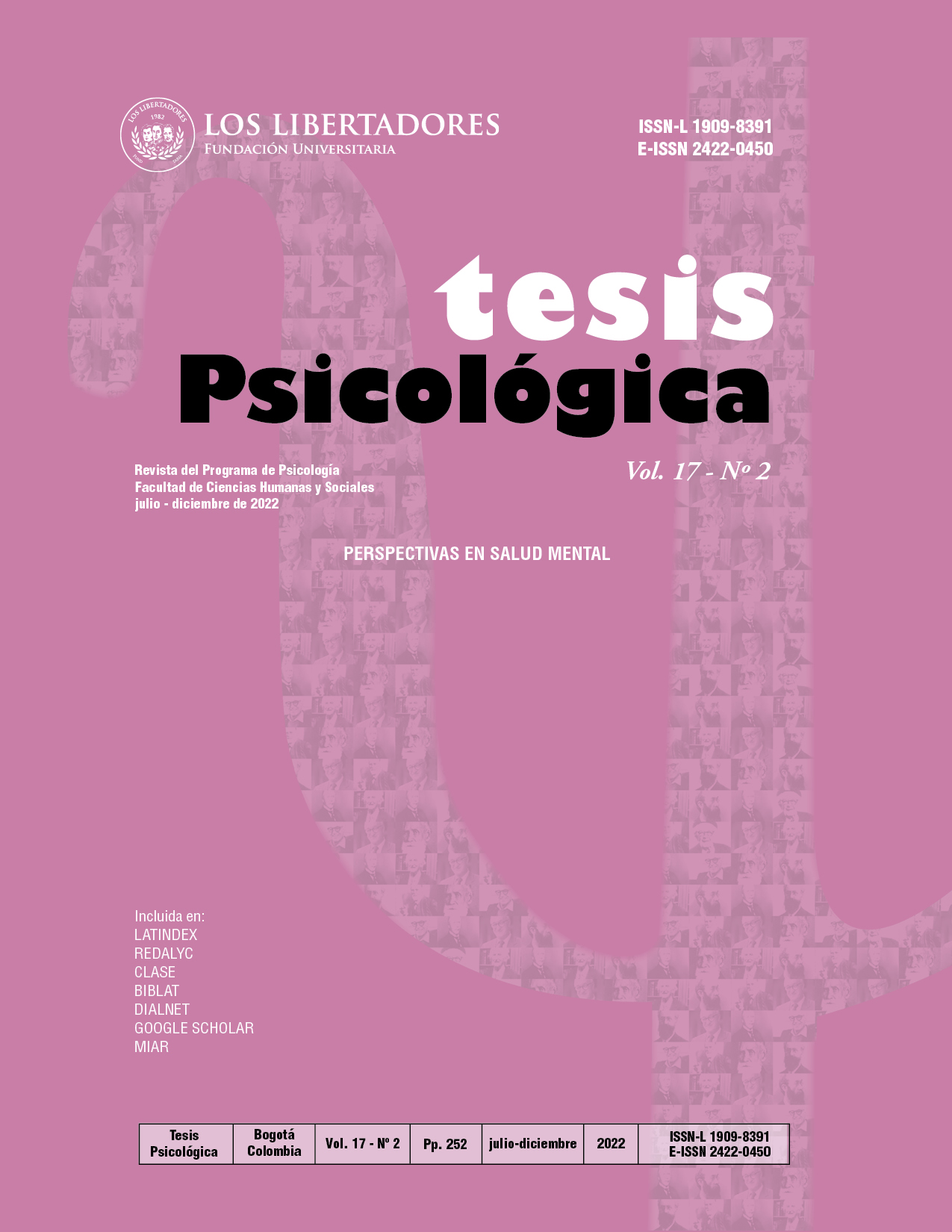Actitudes de estudiantes y docentes de psicología ante el uso de tecnologías en las intervenciones clínicas
DOI:
https://doi.org/10.37511/tesis.v17n2a8Resumen
Antecedentes: En los últimos años se ha incrementado el uso de intervenciones psicológicas digitales o mediadas por tecnología, sin embargo, existe evidencia de que las actitudes de los terapeutas podría ser un factor que influye para incorporarlas en la práctica clínica. Objetivo: Explorar las actitudes de los psicólogos en formación y profesionistas en psicología ante las intervenciones mediadas por dispositivos digitales, así como identificar los factores que influyen en dichas actitudes. Método: El estudio incluyó dos fases, la primera consistió en la adaptación transcultural al contexto mexicano del protocolo CATAS, mediante la evaluación de la validez de contenido (utilizando el método de validación por jueces) a través de la estimación del Índice de Acuerdo entre Jueces-IA y el Coeficiente V de Aiken-V. Posteriormente, se realizó la aplicación del protocolo a una muestra total de 147 participantes (estudiantes y profesores de psicología). Resultados: Reportaron que el protocolo obtuvo una adecuada validez de contenido (IA = 96.54%, V = 0.97 p<.001) y fiabilidad para las escalas que lo componen; CATAS total (α = .76), CFS (α = .83) y EBPAS-Apertura (α = .86). Asimismo, los participantes mostraron actitudes positivas hacia las intervenciones digitales, este tipo de actitudes se asoció con la facilidad de acceso tecnológico, familiaridad con la tecnología (escala CFS), disposición para utilizar nuevos tratamientos (escala EBPAS-Apertura), años de experiencia, ser profesor, un mayor grado académico y con la orientación teórica cognitivo-conductual y sistémico. Conclusiones: Los hallazgos permitirán generar acciones para modificar las barreras que dificultan el uso de las tecnologías en la práctica clínica.
Descargas
Referencias
Abrams, Z. (2020, July 1). How well is telepsychology working? Monitor on Psychology, 51(5). Recuperado de http://www.apa.org/monitor/2020/07/cover-telepsychology
Aiken, L. R. (1985). Three coefficients for analyzing the reliability and validity of ratings. Educational and Psychological Measurement, 45(1), 131–142. Recuperado de https://journals.sagepub.com/doi/abs/10.1177/0013164485451012
Ajzen, I. (1985). From intention to actions: a theory of planned behavior. En J. Kul & J. Beckmann (Eds.), Action control: From cognition to behavior (11-39). Berlin: Springer-Verlag.
Ajzen, I. (1991). The theory of planned behavior. Organizational Behavior and Human Decision Processes, 50(2), 179-211. Recuperado de https://doi.org/10.1016/0749-5978(91)90020-T
American Psychological Association. (2013). Guidelines for the practice of telepsychology. American Psychologist, 68(9), 791-800. Recuperado de http://dx.doi.org/10.1037/a0035001
Bautista, E. (2020). Actitudes de Psicólogos en Formación y Profesionistas ante Intervenciones en Línea Autoaplicadas (Tesis de Licenciatura, Universidad Nacional Autónoma de México). Recuperado de http://132.248.9.195/ptd2022/junio/0826141/Index.html
Becker, E. (2012). Computer Fluency, Access to Technology, and Attitudes Towards Technologically-Based Therapeutic Tools Among Practicing Clinicians (Tesis de Maestría). Recuperado de https://scholarlyrepository.miami.edu/cgi/viewcontent.cgi?article=1352&context=oa_theses
Becker, E., & Jensen-Doss, A. (2013). Computer-Assisted Therapies: Examination of Therapist-Level Barriers to Their Use. Behavior Therapy, 44(4), 614-624. Recuperado de https://doi.org/10.1016/j.beth.2013.05.002
Békés, V., & Aafjes-van Doorn, K. (2020). Psychotherapists' attitudes towards online therapy during the COVID-19 pandemic. Journal of Psychotherapy Integration, 30(2), 238–247. http://dx.doi.org/10.1037/int0000214
Bertuzzi, V., Semonella, M., Bruno, D., Manna, C., Edbrook-Childs, J., Giusti, E. M., … Pietrabissa, G. (2021). Psychological Support Interventions for Healthcare Providers and Informal Caregivers during the COVID-19 Pandemic: A Systematic Review of the Literature. International journal of environmental research and public health, 18(13), 6939. Recuperado de https://doi.org/10.3390/ijerph18136939
Bunge, E., López, P., Mandil, J., Gomar, M., & Borgialli, R. (2009). Actitudes de los terapeutas argentinos hacia la incorporación de nuevas tecnologías en psicoterapia. Revista Argentina de Clínica Psicológica, 18(3), 209-216. Recuperado de http://dx.doi.org/10.24205/03276716.2019.1121
Bunz, U. (2004). The Computer-Email-Web (CEW) Fluency Scale-Development and validation. International Journal of Human Computer Interaction, 17(4), 279–506. Recuperado de https://doi.org/10.1207/s15327590ijhc1704_3
Cipolletta, S., & Mocellin, D. (2018). Online counseling: An exploratory survey of Italian psychologists' attitudes towards new ways of interaction. Psychotherapy research: journal of the Society for Psychotherapy Research, 28(6), 909–924. Recuperado de https://doi.org/10.1080/10503307.2016.1259533
Cohen, J. (1988). Statistical Power Analysis for the Behavioral Sciences. New York: Hillsdale Lawrence Erlbaum Associates.
Committee on National Security Systems. (2010). National Information Assurance Glossary. Recuperado de https://www.hsdl.org/?view&did=7447
De Witte, N., Joris, S., Van Assche, E., & Van Daele, T. (2021). Technological and Digital Interventions for Mental Health and Wellbeing: An Overview of Systematic Reviews. Frontiers in digital health, 3, 754337. Recuperado de https://doi.org/10.3389/fdgth.2021.754337
Distefano, M., Cataldo, G., Mongelo, M., Mesurado, B., & Lamas, M. (2018). Conocimiento y uso de tecnologías digitales en psicoterapia entre los psicólogos de Buenos Aires. Perspectivas en Psicología: Revista de Psicología y Ciencias Afines, 15(1), 65-74. Recuperado de http://perspectivas.mdp.edu.ar/revista/index.php/pep/article/view/354
Entenberg, G., Ciliberti, A. G., Ruiz, E., Nishimuta, K. A., & Bunge, E. L. (2019). Actitudes de los terapeutas argentinos hacia la incorporación de nuevas tecnologías en psicoterapia: diez años de evolución. Revista Argentina de Clínica Psicológica, 18(3), 304-313. DOI: 10.24205/03276716.2019.1121
Escurra-Mayaute, L. M. (1988). Cuantificación de la validez de contenido por criterio de jueces. Revista de Psicología, 6(1-2), 103-111. Recuperado de https://doi.org/10.18800/psico.198801-02.008
Glueckauf, R. L., Maheu, M. M., Drude, K. P., Wells, B. A., Wang, Y., Gustafson, D. J., & Nelson, E.L. (2018). Survey of psychologists' telebehavioral health practices: technology use, ethical issues, and training needs. Professional Psychology: Research and Practice, 49(3), 205–219. Recuperado de https://psycnet.apa.org/doi/10.1037/pro0000188
González-Peña, P., Torres, R., Del Barrio, V., & Olmedo, M. (2017). Uso de las nuevas tecnologías por parte de los psicólogos españoles y sus necesidades. Clínica y salud, 28(2), 81-91. Recuperado de https://doi.org/10.1016/j.clysa.2017.01.001
Heinssen, R. K., Glass, C. R., & Knight, L. A. (1987). Assessing computer anxiety: Development and validation of the Computer Anxiety Rating Scale. Computers in Human Behavior, 3(1), 49–59. Recuperado de https://doi.org/10.1016/0747-5632(87)90010-0
Hernández, R., Fernández, C., & Baptista, P. (2014). Metodología de la investigación. México: McGraw-Hill.
Humer, E., Stippl, P., Pieh, C., Pryss, R., & Probst, T. (2020). Experiences of Psychotherapists With Remote Psychotherapy During the COVID-19 Pandemic: Cross-sectional Web-Based Survey Study. Journal of medical Internet research, 22(11), e20246. https://doi.org/10.2196/20246
Jiménez-Molina, A., Franco, P., Martínez, V., Martínez, P., Rojas, G., & Araya, R. (2019). Internet-Based Interventions for the Prevention and Treatment of Mental Disorders in Latin America: A Scoping Review. Frontiers in psychiatry, 10(664), 1-17. Recuperado de https://doi.org/10.3389/fpsyt.2019.00664
Luo, C., Sanger, N., Singhal, N., Pattrick, K., Shams, I., Shahid, H., … Samaan, Z. (2020). A comparison of electronically-delivered and face to face cognitive behavioural therapies in depressive disorders: A systematic review and meta-analysis. EClinicalMedicine, 24, 100442. Recuperado de https://doi.org/10.1016/j.eclinm.2020.10044 2
Meisel, S. F., Drury, H., & Perera-Delcourt, R. P. (2018). Therapists’ attitudes to offering eCBT in an innercity IAPT service: A survey study. The Cognitive Behaviour Therapist, 11(e11), 1-16. Recuperado de https://doi.org/10.1017/S1754470X18000107
Mendes-Santos, C., Weiderpass, E., Santana, R., & Andersson G. (2020). Portuguese Psychologists' Attitudes Toward Internet Interventions: Exploratory Cross-Sectional Study. JMIR Mental Health, 7(4), e16817. https://doi.org/10.2196/16817
Perle, J. G., Langsam, L. C., Randel, A., Lutchman, S., Levine, A. B., Odland, A. P., … Marker, C. D. (2013). Attitudes toward psychological telehealth: current and future clinical psychologists' opinions of internet-based interventions. Journal of clinical psychology, 69(1), 100–113. https://doi.org/10.1002/jclp.21912
Philippe, T. J., Sikder, N., Jackson, A., Koblanski, M. E., Liow, E., Pilarinos, A., & Vasarhelyi, K. (2022). Digital Health Interventions for Delivery of Mental Health Care: Systematic and Comprehensive Meta-Review. JMIR mental health, 9(5), e35159. https://doi.org/10.2196/35159
Rettinger, L., Klupper, C., Werner, F., & Putz, P. (2021). Changing attitudes towards teletherapy in Austrian therapists during the COVID-19 pandemic. Journal of telemedicine and telecare, 1357633X20986038. Recuperado de https://doi.org/10.1177/1357633X20986038
Sammons, M. T., VandenBos, G. R., & Martin, J. N. (2020). Psychological Practice and the COVID-19 Crisis: A Rapid Response Survey. Journal of health service psychology, 46(2), 51–57. Recuperado de https://doi.org/10.1007/s42843-020-00013-2
Sampaio, M., Haro, M., De Sousa, B., Melo, W. V., & Hoffman, H. G. (2021). Therapists Make the Switch to Telepsychology to Safely Continue Treating Their Patients During the COVID-19 Pandemic. Virtual Reality Telepsychology May Be Next. Frontiers in virtual reality, 1, 576421. Recuperado de https://doi.org/10.3389/frvir.2020.576421
Sánchez, J. (2017). Actitudes de los estudiantes de psicología y de enfermería en el uso de las Tics en clínica (Tesis de grado, Universitat Jaume I). Recuperado de http://hdl.handle.net/10234/169353
Santoro, E. (2022). Interventi psicologici su Internet e terapie digitali nell’ambito della salute mentale: siamo pronti? [Psychological interventions on the Internet and digital therapeutics in the field of mental health: are we ready?]. Recenti progressi in medicina, 113(4), 231–233. Recuperado de https://doi.org/10.1701/3792.37762
Varker, T., Brand, R. M., Ward, J., Terhaag, S., & Phelps, A. (2019). Efficacy of synchronous telepsychology interventions for people with anxiety, depression, posttraumatic stress disorder, and adjustment disorder: A rapid evidence assessment. Psychological services, 16(4), 621–635. Recuperado de https://doi.org/10.1037/ser0000239
Zaçe, D., Hoxhaj, I., Orfino, A., Viteritti, A. M., Janiri, L., & Di Pietro, M. L. (2021). Interventions to address mental health issues in healthcare workers during infectious disease outbreaks: A systematic review. Journal of psychiatric research, 136, 319–333. Recuperado de https://doi.org/10.1016/j.jpsychires.2021.02.019
Descargas
Publicado
Número
Sección
Licencia

Esta obra está bajo una Licencia Creative Commons Atribución-NoComercial-















